Papers by Stavros Dimitriadis
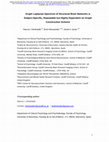
bioRxiv (Cold Spring Harbor Laboratory), Jun 4, 2023
The human brain is a complex network that can be summarized as a graph where nodes refer to anato... more The human brain is a complex network that can be summarized as a graph where nodes refer to anatomical brain regions while edges encode the neuronal interactions or structural connections between them at both the micro and macroscopic levels, allowing the application of graph theory to investigate the network brain architecture. Various network metrics have been proposed and adopted so far describing both local and global properties of the relevant brain network. It has been proposed that connectomic harmonic patterns that emerged from the brain's structural network underlie the human brain's resting-state activity. Connectome harmonics refer to Laplacian eigenfunctions of the structural connectivity matrices (2D) and is an extension of the well-known Fourier basis of a signal (1D). The estimation of the normalized graph Laplacian over a brain network's spectral decomposition can reveal the connectome harmonics (eigenvectors) corresponding to certain frequencies (eigenvalues). Here, we used test-retest dMRI data from the Human Connectome Project to explore the repeatability of connectome harmonics and eigenvalues across five graph construction schemes. Normalized Laplacian eigenvalues were found to be subject-specific and repeatable across the five graph construction schemes, but their range is highly dependent on the graph construction scheme. The repeatability of connectome harmonics is lower than that of the Laplacian eigenvalues and shows a heavy dependency on the graph construction scheme. In parallel, we investigated the properties of the structural networks and their relationship with the Laplacian spectrum. Our results provide a proof of concept for repeatable identification of the graph Laplacian spectrum of structural brain networks based on the selected graph construction scheme.
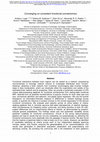
Functional interactions between brain regions can be viewed as a network, empowering neuroscienti... more Functional interactions between brain regions can be viewed as a network, empowering neuroscientists to leverage network science to investigate distributed brain function. However, obtaining a brain network from functional neuroimaging data involves multiple steps of data manipulation, which can drastically affect the organisation and validity of the estimated brain network and its properties. Here, we provide a systematic evaluation of 576 unique data-processing pipelines for functional connectomics from resting-state functional MRI, obtained from all possible recombinations of popular choices for brain atlas type and size, connectivity definition and selection, and global signal regression. We use the portrait divergence, an information-theoretic measure of differences in network topology across scales, to quantify the influence of analytic choices on the overall organisation of the derived functional connectome. We evaluate each pipeline across an entire battery of criteria, seek...
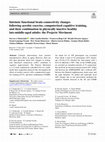
GeroScience
Lifestyle interventions have positive neuroprotective effects in aging. However, there are still ... more Lifestyle interventions have positive neuroprotective effects in aging. However, there are still open questions about how changes in resting-state functional connectivity (rsFC) contribute to cognitive improvements. The Projecte Moviment is a 12-week randomized controlled trial of a multimodal data acquisition protocol that investigated the effects of aerobic exercise (AE), computerized cognitive training (CCT), and their combination (COMB). An initial list of 109 participants was recruited from which a total of 82 participants (62% female; age = 58.38 ± 5.47) finished the intervention with a level of adherence > 80%. Only in the COMB group, we revealed an extended network of 33 connections that involved an increased and decreased rsFC within and between the aDMN/pDMN and a reduced rsFC between the bilateral supplementary motor areas and the right thalamus. No global and especially local rsFC changes due to any intervention mediated the cognitive benefits detected in the AE and C...

Cerebral Cortex, Jul 14, 2022
Research studies based on tractography have revealed a prominent reduction of asymmetry in some k... more Research studies based on tractography have revealed a prominent reduction of asymmetry in some key white-matter tracts in schizophrenia (SCZ). However, we know little about the inf luence of common genetic risk factors for SCZ on the efficiency of routing on structural brain networks (SBNs). Here, we use a novel recall-by-genotype approach, where we sample young adults from a populationbased cohort (ALSPAC:N genotyped = 8,365) based on their burden of common SCZ risk alleles as defined by polygenic risk score (PRS). We compared 181 individuals at extremes of low (N = 91) or high (N = 90) SCZ-PRS under a robust diffusion MRI-based graph theoretical SBN framework. We applied a semi-metric analysis revealing higher SMR values for the high SCZ-PRS group compared with the low SCZ-PRS group in the left hemisphere. Furthermore, a hemispheric asymmetry index showed a higher leftward preponderance of indirect connections for the high SCZ-PRS group compared with the low SCZ-PRS group (P FDR < 0.05). These findings might indicate less efficient structural connectivity in the higher genetic risk group. This is the first study in a population-based sample that reveals differences in the efficiency of SBNs associated with common genetic risk variants for SCZ.
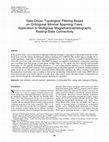
Brain connectivity, Dec 1, 2017
In the present study, a novel data-driven topological filtering technique is introduced to derive... more In the present study, a novel data-driven topological filtering technique is introduced to derive the backbone of functional brain networks relying on orthogonal minimal spanning trees (OMSTs). The method aims to identify the essential functional connections to ensure optimal information flow via the objective criterion of global efficiency minus the cost of surviving connections. The OMST technique was applied to multichannel, resting-state neuromagnetic recordings from four groups of participants: healthy adults (n = 50), adults who have suffered mild traumatic brain injury (n = 30), typically developing children (n = 27), and reading-disabled children (n = 25). Weighted interactions between network nodes (sensors) were computed using an integrated approach of dominant intrinsic coupling modes based on two alternative metrics (symbolic mutual information and phase lag index), resulting in excellent discrimination of individual cases according to their group membership. Classification results using OMST-derived functional networks were clearly superior to results using either relative power spectrum features or functional networks derived through the conventional minimal spanning tree algorithm.

Schizophrenia Bulletin, Oct 18, 2021
Schizophrenia (SCZ) is associated with structural brain changes, with considerable variation in t... more Schizophrenia (SCZ) is associated with structural brain changes, with considerable variation in the extent to which these cortical regions are influenced. We present a novel metric that summarises individual structural variation across the brain, while considering prior effect sizes, established via meta-analysis. We determine individual participant deviation from a within-sample-norm across structural MRI regions of interest (ROIs). For each participant, we weight the normalised deviation of each ROI by the effect size (Cohen's d) of the difference between SCZ/control for the corresponding ROI from the SCZ Enhancing Neuroimaging Genomics through Meta-Analysis working group. We generate a morphometric risk score (MRS) representing the average of these weighted deviations. We investigate if SCZ-MRS is elevated in a SCZ case/control sample (N CASE = 50; N CONTROL = 125), a replication sample (N CASE = 23; N CONTROL = 20) and a sample of asymptomatic young adults with extreme SCZ polygenic risk (N HIGH-SCZ-PRS = 95; N LOW-SCZ-PRS = 94). SCZ cases had higher SCZ-MRS than healthy controls in both samples (Study 1: β = 0.62, P < 0.001; Study 2: β = 0.81, P = 0.018). The high liability SCZ-PRS group also had a higher SCZ-MRS (Study 3: β = 0.29, P = 0.044). Furthermore, the SCZ-MRS was uniquely associated with SCZ status, but not attention-deficit hyperactivity disorder (ADHD), whereas an ADHD-MRS was linked to ADHD status, but not SCZ. This approach provides a promising solution when considering individual heterogeneity in SCZ-related brain alterations by identifying individual's patterns of structural brain-wide alterations.
Clinical Neurophysiology, Apr 1, 2018
Cit a tio n fo r fin al p u blis h e d ve r sio n: Di mit ri a di s, S t a v r o s , S alis, C h ... more Cit a tio n fo r fin al p u blis h e d ve r sio n: Di mit ri a di s, S t a v r o s , S alis, C h ris t o s a n d Lin d e n, D avi d 2 0 1 8. A n ov el, fa s t a n d effici e n t si n gl e-s e n s o r a u t o m a ti c sl e e p-s t a g e cl a s sific a tio n b a s e d o n c o m pl e m e n t a r y c r o s s-fr e q u e n cy c o u pli n g e s ti m a t e s. Clinic al N e u r o p hy siolo gy 1 2 9 (4) , p p. 8 1 5-8 2 8. 1 0. 1 0 1 6/j.clin p h. 2 0 1 7. 1 2. 0 3 9 Highlights Cross-Frequency Coupling (CFC) is a key mechanism of brain interactions in sleep. Different estimates of CFC contribute to high sleep stage classification accuracy. Single-Sensor Automatic Single Sensor Classification can provide a means of alternative low-cost sleep monitoring.
2022 44th Annual International Conference of the IEEE Engineering in Medicine & Biology Society (EMBC), Jul 11, 2022
Code for estimating the sources, the functional brain networksand the classification performance.
The 1\(^\text {st}\) edition of the Brain-Driven Computer Vision Workshop, held in Munich in conj... more The 1\(^\text {st}\) edition of the Brain-Driven Computer Vision Workshop, held in Munich in conjunction with the European Conference on Computer Vision 2018, aimed at attracting, promoting and inspiring research on paradigms, methods and tools for computer vision driven or inspired by the human brain. While successful, in terms of the quality of received submissions and audience present at the event, the workshop emphasized some of the factors that currently limit research in this field. In this report, we discuss the success points of the workshop, the characteristics of the presented works, and our considerations on the state of current research and future directions of research in this topic.
Brain Sciences, Oct 19, 2022
This article is an open access article distributed under the terms and conditions of the Creative... more This article is an open access article distributed under the terms and conditions of the Creative Commons Attribution (CC BY
Frontiers in Neuroinformatics, 2016
Frontiers in Neuroinformatics, 2016
Clinical Neurophysiology, 2016
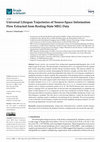
Brain Sciences
Source activity was extracted from resting-state magnetoencephalography data of 103 subjects aged... more Source activity was extracted from resting-state magnetoencephalography data of 103 subjects aged 18–60 years. The directionality of information flow was computed from the regional time courses using delay symbolic transfer entropy and phase entropy. The analysis yielded a dynamic source connectivity profile, disentangling the direction, strength, and time delay of the underlying causal interactions, producing independent time delays for cross-frequency amplitude-to-amplitude and phase-to-phase coupling. The computation of the dominant intrinsic coupling mode (DoCM) allowed me to estimate the probability distribution of the DoCM independently of phase and amplitude. The results support earlier observations of a posterior-to-anterior information flow for phase dynamics in {α1, α2, β, γ} and an opposite flow (anterior to posterior) in θ. Amplitude dynamics reveal posterior-to-anterior information flow in {α1, α2, γ}, a sensory-motor β-oriented pattern, and an anterior-to-posterior pat...
Precomputed intra and inter-frequency brain networks:<br>-Correlation of the Envelope-iPLV-PLV
Code for estimating the sources, the functional brain networksand the classification performance.






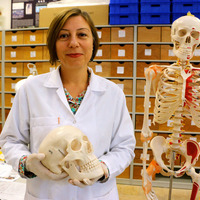

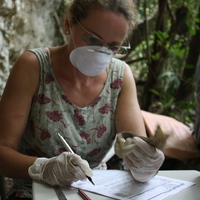

Uploads
Papers by Stavros Dimitriadis